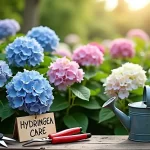Peat moss is good for hydrangeas. This amazing substrate not only ensures moisture retention but also contributes to nutrient availability and pH balance, making it a popular choice among hydrangea enthusiasts.
Why Use Peat Moss for Hydrangeas?
-
Moisture Retention
Hydrangeas thrive in consistently moist, well-draining soils. Peat moss is known for its remarkable ability to absorb and retain moisture, providing a constant supply that helps prevent the plants from drying out. This is especially vital during hot summer months or in drought-prone areas. -
Nutrient Retention
One of the key benefits of peat moss is its ability to retain nutrients in the soil. This means that essential nutrients, such as nitrogen, phosphorus, and potassium, can be held in the root zone, making them available for hydrangeas to absorb. -
Acidic pH Level
Many hydrangeas prefer slightly acidic soil, and peat moss helps create these conditions. The natural acidity of peat moss can help maintain a pH level between 5.5 to 6.5, which is ideal for hydrangea growth.
Nutritional Needs of Hydrangeas
| Nutrient | Importance | Sources |
|---|---|---|
| Nitrogen | Promotes leaf growth and green foliage | Organic fertilizers, compost |
| Phosphorus | Aids in root development and blooming | Bone meal, fish emulsion |
| Potassium | Enhances flower quality and drought tolerance | Wood ash, kelp meal |
The Ideal Soil Mix
Creating the perfect soil mix for hydrangeas involves several components, and peat moss plays a crucial role. Here’s a recommended mix:
- 80% Soil: Poised as the base, you can use a high-quality garden soil suitable for flowers.
- 20% Peat Moss: This amounts to about one part peat moss for every four parts of garden soil.
Note: Adjust the ratio based on specific soil conditions and Hydrangea Types.
Benefits of Adding Peat Moss
-
Improved Drainage: While retaining moisture, peat moss also improves soil texture, ensuring that excess water drains away, preventing root rot.
-
Enhancing Soil Structure: Peat moss helps in creating a crumbly soil structure that’s easy for roots to penetrate. This aeration is critical for vigorous root growth.
-
Encouraging Beneficial Microorganisms: The organic nature of peat moss supports a healthy ecosystem of microorganisms in the soil, which can be invaluable for disease resistance and nutrient breakdown.
How to Incorporate Peat Moss into Hydrangea Care
Here’s a step-by-step guide to incorporating peat moss when planting or caring for hydrangeas:
-
Select A Planting Site: Choose a location that receives ample sunlight, as hydrangeas thrive in partial to full sun.
-
Prepare the Soil: Remove any weeds, rocks, or debris, and loosen the soil to a depth of at least 12 inches.
-
Mix Peat Moss with Soil: Create the ideal soil mix by combining garden soil with peat moss at a ratio of 80:20.
-
Plant Hydrangeas: Dig a hole large enough to accommodate the root ball, place the plant inside, and backfill with your prepared soil mix.
-
Watering: Water the newly planted hydrangeas generously to help settle the soil and ensure moisture retention.
Best Practices for Hydrangea Care with Peat Moss
-
Monitor Moisture Levels: Regularly check soil moisture, especially during dry spells. Hydrangeas often indicate their needs by wilting leaves.
-
Fertilize: Use organic fertilizers periodically to ensure they receive adequate nutrients, particularly during their active growth period from March to September.
-
Pruning: Prune hydrangeas according to their variety to encourage healthy growth and flowering.
Frequently Asked Questions (FAQs)
Q: How often should I add peat moss to my hydrangea soil?
A: It’s recommended to refresh the soil mix with peat moss at least once every two years, especially as the organic matter decomposes over time.
Q: Can I use peat moss with Other soil amendments?
A: Absolutely! Combining peat moss with compost or well-rotted manure can create a nutrient-rich environment for hydrangeas.
Q: Are there any disadvantages to using peat moss?
A: Yes, peat moss is not a renewable resource, and its extraction can harm natural ecosystems. Consider using eco-friendly alternatives such as coconut coir when possible.
Q: Does peat moss affect the color of hydrangeas?
A: Yes! The pH level influenced by peat moss can affect flower color, especially in bigleaf hydrangeas. Acidic conditions (below 6.0) can lead to blue flowers, while alkaline conditions tend to produce pink blossoms.
Additional Tips for Hydrangea Enthusiasts
- Monitor pH Regularly: Use soil testing kits to ensure that pH levels stay within the preferred range for optimal growth.
- Avoid Overwatering: Even though peat moss retains moisture, it’s crucial to avoid letting the hydrangeas sit in waterlogged soil.
- Consider Local Conditions: Tailor your soil mix and care to suit your local climate and environmental conditions to get the best results from your hydrangeas.
For more in-depth information on Hydrangea Care, visit [Stark Bro’s](https://www.starkbros.com/growing-guide/how-to-grow/garden-plants/hydrangeas/soil-preparation

